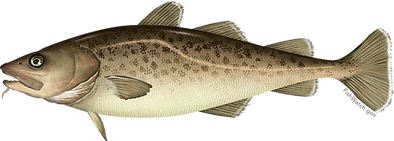

TARGET SPECIES
& FISHING PRACTICES
AWTA Target Species

Walleye pollock (Theragra chalcogramma) is the largest fishery in Alaska (comprising 55.8% of total groundfish catch in 2010). Pollock is a semipelagic schooling fish widely distributed in the North Pacific Ocean with the largest concentrations found in the eastern Bering Sea.
Pollock (Theragra chalcogramma)
77% of total catch

There are 37 species of rockfish that live in Alaskan waters, and three species comprise 90% of our harvest in the Gulf of Alaska. Two pelagic species of Pacific Ocean Perch (64M lbs annually) and Dusky Rockfish (3.5M lbs annually), and the non-pelagic species Northern Rockfish (7M lbs annually).
Rockfish
10% of total catch
Primary Rockfish Targets
Northern Rockfish (Sebastes polyspinis) -
Pacific Ocean Perch (Sebastes alutus) -
Dusky Rockfish (Sebastes variabilis) -
Rougheye Rockfish (Sebastes aleutianus)
Shortraker Rockfish (Sebastes borealis)
Thornyhead Rockfish (Sebastolobus alascanus)

Pacific cod (Gadus macrocephalus), also known as grey cod, are moderately fast growing and relatively short-lived fish, with a maximum age of approximately 18 years. Females reach 50% maturity at 4.4 years in the Gulf of Alaska (Alaska Fisheries Science Center).
Pacific Cod (Gadus macrocephalus)
7% of total catch

There are more than 10 species of flatfish harvested in Alaska and we target 5 of them in the Gulf of Alaska (arrowtooth, northern & southern rock sole, rex sole, flathead sole) Flatfish start out shaped like a normal fish and then flatten out a few weeks after hatching, adapting to life on the seafloor.
Flatfish
5% of total catch
Arrowtooth Flounder (Atheresthes stomias) -
Northern Rock Sole (Lepidopsetta polyxstra) -
Rex Sole (Glyptocephalus zachirus) -
Flathead Sole -
Southern Rock Sole -
For More Species Information Visit the NOAA Species Directory
AWTA Species Fact Sheets
Courtesy of Alaska Seafood Marketing Institute
Primary Flatfish Targets
HOW WE FISH
Primary components of trawl gear are a net, trawl doors, sweeps and cod end. In the GOA there are generally two types of trawl nets: Pelagic Trawl, also known as mid-water trawl, and Non-Pelagic Trawl, also known as bottom trawl.
Pelagic Trawl/Mid-water trawl: A mid-water trawl stays in the middle of the water column and makes little to no contact with the bottom. Species generally targeted with a mid-water trawl include pollock and Pacific Ocean Perch (POP).
Non-Pelagic Trawl, bottom trawl: A bottom trawl operates along the bottom of the seafloor. Since 2015 bottom trawl gear in the Gulf of Alaska is required to have modified sweeps that hold gear off of the bottom and significantly reduce seafloor impact. Read more about sustainability.



ADVANCEMENTS IN GEAR TECHNOLOGY
Transition from Bottom Trawls to Pelagic Trawls. Most Gulf trawling today is conducted with pelagic, or mid-water, trawls. Mid-water trawls stay in the middle of the water column and have very little contact, if any, with the seafloor.
Modified Sweeps for bottom trawling. In response to concerns about “hard on the bottom” trawling Gulf trawlers have used modified sweeps in the flatfish fishery since 2014. The modified sweeps keep the gear off the bottom and ensure a minimum of 2.5 inches between the sweeps and the seafloor. (Amendment 89 to GOA FMP).
AWTA helped write a successful grant proposal for an electronic monitoring (EM) pilot project in the pollock mid-water trawl fisheries in the Bering Sea and Gulf of Alaska.

Halibut and Salmon Excluders. Our members actively engage in research and development of halibut and salmon excluders, and most GOA trawlers currently use them. Excluders are built into trawl nets and are designed based on different swimming characteristics of different species to exclude the non-target fish species. For example, halibut and chinook salmon are generally stronger swimmers than flounder and pollock, and excluder devices allow halibut and chinook to exit the trawl nets, thereby reducing Prohibited Species Catch (PSC).



